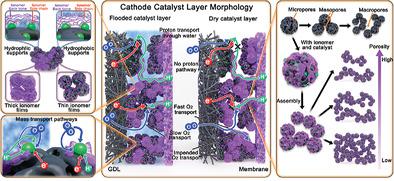当前位置:
X-MOL 学术
›
Adv. Energy Mater.
›
论文详情
Our official English website, www.x-mol.net, welcomes your
feedback! (Note: you will need to create a separate account there.)
Engineering Catalyst Layers for Next-Generation Polymer Electrolyte Fuel Cells: A Review of Design, Materials, and Methods
Advanced Energy Materials ( IF 24.4 ) Pub Date : 2021-08-26 , DOI: 10.1002/aenm.202101025 Theo A. M. Suter 1 , Keenan Smith 1 , Jennifer Hack 1 , Lara Rasha 1 , Zahra Rana 1 , Gyen Ming A. Angel 1 , Paul R. Shearing 1 , Thomas S. Miller 1 , Dan J. L. Brett 1
Advanced Energy Materials ( IF 24.4 ) Pub Date : 2021-08-26 , DOI: 10.1002/aenm.202101025 Theo A. M. Suter 1 , Keenan Smith 1 , Jennifer Hack 1 , Lara Rasha 1 , Zahra Rana 1 , Gyen Ming A. Angel 1 , Paul R. Shearing 1 , Thomas S. Miller 1 , Dan J. L. Brett 1
Affiliation

|
Polymer electrolyte fuel cells (PEFCs) are a promising replacement for the fossil fuel–dependent automotive and energy sectors. They have become increasingly commercialized in the last decade; however, significant limitations on durability and performance limit their commercial uptake. Catalyst layer (CL) design is commonly reported to impact device power density and durability; although, a consensus is rarely reached due to differences in testing conditions, experimental design, and types of data reported. This is further exacerbated by aspects of CL design such as catalyst support, proton conduction, catalyst, fabrication, and morphology, being significantly interdependent; hence, a wider appreciation is required in order to optimize performance, improve durability, and reduce costs. Here, the cutting-edge research within the field of PEFCs is reviewed, investigating the effect of different manufacturing techniques, electrolyte distribution, support materials, surface chemistries, and total porosity on power density and durability. These are critically appraised from an applied perspective to inform the most relevant and promising pathways to make and test commercially viable cells. This holistic view of the competing aspects of CL design and preparation will facilitate the development of optimized CLs, especially the incorporation of novel catalyst support materials.
中文翻译:

用于下一代聚合物电解质燃料电池的工程催化剂层:设计、材料和方法综述
聚合物电解质燃料电池 (PEFC) 是依赖化石燃料的汽车和能源行业的有前途的替代品。在过去十年中,它们变得越来越商业化。然而,耐用性和性能方面的重大限制限制了它们的商业应用。据报道,催化剂层 (CL) 设计通常会影响设备功率密度和耐用性;但是,由于测试条件、实验设计和报告数据类型的差异,很少能达成共识。CL 设计的各个方面进一步加剧了这种情况,例如催化剂载体、质子传导、催化剂、制造和形态,它们之间显着相互依赖;因此,为了优化性能、提高耐用性和降低成本,需要更广泛的认识。这里,回顾了 PEFC 领域的前沿研究,研究了不同制造技术、电解质分布、支撑材料、表面化学和总孔隙率对功率密度和耐久性的影响。从应用的角度对这些进行了严格的评估,以告知制造和测试商业可行细胞的最相关和最有希望的途径。这种对 CL 设计和制备竞争方面的整体看法将促进优化 CL 的开发,尤其是新型催化剂载体材料的结合。从应用的角度对这些进行了严格的评估,以告知制造和测试商业可行细胞的最相关和最有希望的途径。这种对 CL 设计和制备竞争方面的整体看法将促进优化 CL 的开发,尤其是新型催化剂载体材料的结合。从应用的角度对这些进行了严格的评估,以告知制造和测试商业可行细胞的最相关和最有希望的途径。这种对 CL 设计和制备竞争方面的整体看法将促进优化 CL 的开发,尤其是新型催化剂载体材料的结合。
更新日期:2021-10-06
中文翻译:

用于下一代聚合物电解质燃料电池的工程催化剂层:设计、材料和方法综述
聚合物电解质燃料电池 (PEFC) 是依赖化石燃料的汽车和能源行业的有前途的替代品。在过去十年中,它们变得越来越商业化。然而,耐用性和性能方面的重大限制限制了它们的商业应用。据报道,催化剂层 (CL) 设计通常会影响设备功率密度和耐用性;但是,由于测试条件、实验设计和报告数据类型的差异,很少能达成共识。CL 设计的各个方面进一步加剧了这种情况,例如催化剂载体、质子传导、催化剂、制造和形态,它们之间显着相互依赖;因此,为了优化性能、提高耐用性和降低成本,需要更广泛的认识。这里,回顾了 PEFC 领域的前沿研究,研究了不同制造技术、电解质分布、支撑材料、表面化学和总孔隙率对功率密度和耐久性的影响。从应用的角度对这些进行了严格的评估,以告知制造和测试商业可行细胞的最相关和最有希望的途径。这种对 CL 设计和制备竞争方面的整体看法将促进优化 CL 的开发,尤其是新型催化剂载体材料的结合。从应用的角度对这些进行了严格的评估,以告知制造和测试商业可行细胞的最相关和最有希望的途径。这种对 CL 设计和制备竞争方面的整体看法将促进优化 CL 的开发,尤其是新型催化剂载体材料的结合。从应用的角度对这些进行了严格的评估,以告知制造和测试商业可行细胞的最相关和最有希望的途径。这种对 CL 设计和制备竞争方面的整体看法将促进优化 CL 的开发,尤其是新型催化剂载体材料的结合。











































 京公网安备 11010802027423号
京公网安备 11010802027423号